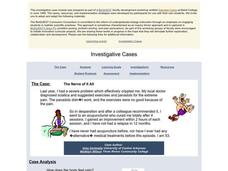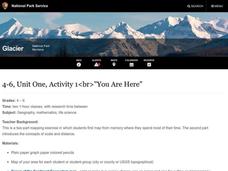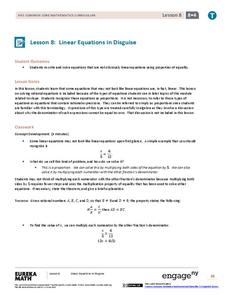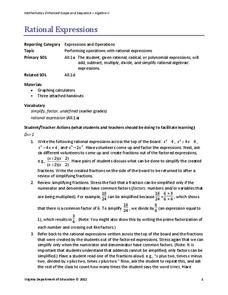Illustrative Mathematics
Dividing by One-Half
Understanding when to divide by two or one-half can be confusing. Here is an activity that gives four different scenarios. It is up to your number crunchers to decide if they divide by two or one-half. The easiest way to approach the...
Illustrative Mathematics
Half of a Recipe
Kids love to cook! What is a better place to learn mixed numbers than with a recipe? It is up to learners to decide how they want to divide this recipe in half. They may choose to model the mixed number and then divide the model by two....
Illustrative Mathematics
Fractions and Rectangles
Visual models are excellent teaching tools when explaining equivalent fractions. Looking at a rectangle cut into twelfths, students first identify the shaded fraction, and then explain whether the fraction is equal to one-fourth....
Illustrative Mathematics
Running to School
The object of this activity is to compute how far Rosa ran to school. Given in the exercise is the fractional number of miles between home and school and the fractional distance Rosa ran. The commentary shows several ways to have your...
Illustrative Mathematics
Converting Decimal Representations of Rational Numbers to Fraction Representations
A rational number is a ratio of two integers. Discuss with your class how to convert the rational numbers of repeating decimals to fractions. A good commentary on letting x equal the repeating decimal and multiplying each side of such...
Curated OER
introducing the Concept: Using Ratios and Percents
Young scholars convert decimals and fractions to percents. For this introductory percents lesson, learners work with equivalent fractions and learn to draw ratios. They recognize how to change a fraction to a percent.
Curated OER
Comparing Apples With Apples 1
Elementary schoolers observe and demonstrate how to add and subtract fractions with like denominators. They observe the teacher model a variety of fraction addition and subtraction problems and use fraction strips to complete a worksheet.
Alabama Learning Exchange
Exponents and Division
Create a human fraction to learn about division of exponents. Scholars develop the rule for division of exponents by being part of a human fraction to explore and justify the rule. They also consider zero exponents and negative exponents.
EngageNY
Grade 5 Math Module 1, Topic E, Lesson 11
Let your understanding of multiplying decimals flourish and multiply. After briefly reviewing place value concepts and how to add and subtract decimals, scholars learn to multiply a decimal fraction (like 0.6) by a whole number. They use...
Curated OER
Cartoon Fractions
Students explore mathematics by viewing cartoons. In this math functions lesson, students read several "Peanut" cartoons on their worksheets as they solve fraction problems and compare them to the comic strip. Students utilize addition,...
Curated OER
Discovering Math Rational Number Concepts
Students research Egyptian hieroglyphics using print and Web resources. THey discuss Egyptian achievements in mathematics. Students explore how Egyptians used hieroglyphics to write numerals. They multiply and divide numbers using the...
Curated OER
Estimation
Fourth graders view a variety of rice products and calculate their cost. In this rice math lesson, 4th graders estimate cost and multiply to find 8 of each item. Students estimate using different amounts of rice products. Students...
Curated OER
Time for a Plumber!
Fourth graders compare amounts of time in seconds, minutes and hours. In this multiplying and comparing time lesson plan, 4th graders problem solve a plumbing problem scenario to find which amount of time is the least. Students share...
EngageNY
Finding a Rate by Dividing Two Quantities
Develop the right station to solve rate word problems. The 18th lesson in a series of 29 starts by interpreting the aspects of rates with two different quantities. Pupils use the interpretation of rates to solve problems, and groups work...
Curated OER
You Are Here
Learners map local places and learn to use scale and distance. In this mapping lesson, students map their school and a favorite place. Learners recreate their maps showing distance and scale sizes. Students locate their location on a...
EngageNY
Linear Equations in Disguise
In the eighth segment of a 33-part unit, learners look at equations that do not appear to be linear at first glance. The equations are proportions where the numerators and denominators may have more than one term. To round out the...
Virginia Department of Education
Rational Expressions
Demonstrate the progression of operations with rational expressions through a multi-day lesson, equipped with worksheets for each day. High schoolers develop the concepts needed to perform operations with rational expressions. They learn...
Curated OER
Face The Facts To Remember
Second graders use manipulatives, drawings, and story problems to learn the two's multiplication tables. After learning how to find answers, they participate in a memory game to match facts and answers.
Curated OER
ExplorA-Pond:4th Grade Perimeter Estimation
Fourth graders visit a real pond. They mark the pond's curvilinear perimeter using string. They measure the string to find the actual perimeter of the pond.
Curated OER
Percentages in Word Problems
Eighth graders, after brainstorming all the places they see percentages in every day life (sales, basketball, grades, etc.), calculate percentages from bases and parts in word problems. They review their notes together on percentage...





















